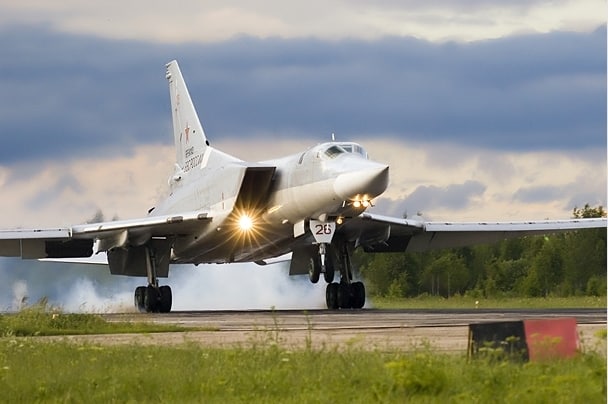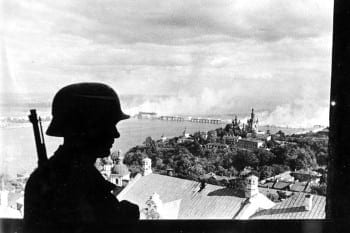Russia’s nuclear preparedness will surprise NATO
![]() THE WEST’S GREAT WAR AGAINST RUSSIA
THE WEST’S GREAT WAR AGAINST RUSSIA
Syria, the Ukraine, and other battlefields are just proxy conflicts. The object is the defeat and destruction of Russia as an independent world power.
[First iteration on 12.11.2014]
 It was the first strategic agreement, after the treacherous policy of Democrats, in which Russia managed to win significant advantages. In the treaty, the Americans, for the first time in history, undertook to reduce their strategic nuclear potential, while Russia won an opportunity to increase it. Furthermore, the new treaty removed important limitations that existed in the previous START 1 and START 2 treaties. It goes about the size of areas for the deployment of mobile ICBMs, the number of multi-charge ICBMs, and the possibility to build railway-based ICBMs. Russia did not make any concessions.
It was the first strategic agreement, after the treacherous policy of Democrats, in which Russia managed to win significant advantages. In the treaty, the Americans, for the first time in history, undertook to reduce their strategic nuclear potential, while Russia won an opportunity to increase it. Furthermore, the new treaty removed important limitations that existed in the previous START 1 and START 2 treaties. It goes about the size of areas for the deployment of mobile ICBMs, the number of multi-charge ICBMs, and the possibility to build railway-based ICBMs. Russia did not make any concessions.
Having written off Moscow as a serious geopolitical rival, flying on the wings of inaccessible military and technological superiority, Washington drove itself into a trap, from which it does not see a way out even on a medium-term perspective.

Recently, a lot has been said about so-called “sixth-generation wars” and high-precision long-range weapons that should ensure victory over the enemy without coming into direct contact with its armed forces. This concept is highly questionable. (The US failed to achieve victory in such a way both in Iraq and Afghanistan). Yet, this is the point where Russia enters the parity line as well. The proof is long-range cruise missiles of a new generation that will soon be deployed on submarines of the Black Sea Fleet and missile ships of the Caspian Flotilla.
In today’s Russia, many find this hard to believe. This is a common belief for many of those, who still enthusiastically remain in captivity of the myths about the absolute “weakness” of Russia and the absolute “superiority” of the West. The myth was made up in the 90’s under the influence of Boris Yeltsin and his betrayal of Russian national interests. One has to admit that during that time, the myth was real, if one may say so.
Times have changed. One can easily understand the new state of affairs.
For example, let’s consider the potential of conventional weapons of Russia and the West in the European Theater of Operations (ETO). In this area, it is generally believed that NATO is a lot stronger than Russia. Yet, a first encounter with reality smashes this misbelief into pieces.
As is known, the main striking force, the core of combat power of the ground forces is tanks. By the time of the collapse of the Soviet Union, the Russian Armed Forces had about 20,000 tanks in the ETO.
The Americans, in turn, deployed 6,000 heavy Abrams tanks on the territory of the allied group. Despite this, the combined potential of NATO forces in Europe was still significantly inferior to the Soviet potential. To compensate this imbalance, NATO strategists were forced to resort to tactical nuclear weapons (TNW).

Russian tanks drive through Tskhinvali, the regional capital of Georgia’s breakaway province of South Ossetia, moving to the Russian border, Saturday, Aug. 30, 2008. Russia has long been a world leader in tank technology.
In the first half of the 1950s, NATO conducted a research about what kind of forces the bloc should have to show reliable resistance to large-scale ground offensive of superior forces of the Soviet Union and Warsaw Pact countries. The calculations showed then that one required at least 96 full-fledged divisions for the purpose. Yet, the cost of armament for one of such divisions exceeded $1 billion. Plus, one required two or three more billion to maintain such a large group of troops and build appropriate infrastructure. This burden was clearly beyond the power of the economy of the West.
The solution was found in a move to deploy a group of US tactical nuclear weapons on the continent, and that was done soon. By the early 1970s, the US arsenal of tactical nuclear weapons counted about 7,000 units of ammunition. The highest achievement in the area was the creation of weapons of selective action – neutron warheads (for guns of 203-mm and 155-mm caliber, and for Lance missiles) with a capacity from 1 to 10 kilotons. The warheads were seen as the key in combating land forces personnel, particularly Soviet tank crews.
Given the nuclear factor, to deflect “Soviet aggression,” NATO required to deploy only 30, rather than 96 divisions, and so they were deployed.
[dropcap]H[/dropcap]ow do things work in this area now? In early 2013, the Americans withdrew the last group of heavy Abrams tanks from Europe. In NATO countries, over the last 20 years, one new tank would replace 10-15 old, yet still capable, tanks. At the same time, Russia was not decommissioning its tanks.
As a result, today Russia is the absolute leader in this regard. In mid-2014, the balance of the Defense Ministry had as many as 18,177 tanks (T-90 – 400 pcs., T-72B – 7,144 pcs., T-80 – 4,744 pcs, T-64 – 4,000 pcs, T-62 – 689 pcs, and T-55 – 1200 pcs.).
Of course, only a few thousand tanks are deployed in permanent readiness units, and most of them remain at storage bases. Yet, NATO has the same picture. Therefore, the decisive superiority of Russian tanks has not gone anywhere since the times of the USSR.
Here is another surprise. As for tactical nuclear weapons, the superiority of modern-day Russia over NATO is even stronger.
The Americans are well aware of this. They were convinced before that Russia would never rise again. Now it’s too late.
To date, NATO countries have only 260 tactical nuclear weapons in the ETO. The United States has 200 bombs with a total capacity of 18 megatons. They are located on six air bases in Germany, Italy, Belgium, the Netherlands and Turkey. France has 60 more atomic bombs. That is pretty much it. Russia, according to conservative estimates, has 5,000 pieces of different classes of TNW – from Iskander warheads to torpedo, aerial and artillery warheads! The US has 300 tactical B-61 bombs on its own territory, but this does not change the situation against the backdrop of such imbalance. The US is unable to improve it either, as it has destroyed the “Cold War legacy” – tactical nuclear missiles, land-based missiles and nuclear warheads of sea-based Tomahawk cruise missiles.
This report is in 2 parts. Read part 2 here.
Pravda.Ru
Дмитрий Судаков
Russia takes advantage of Western military errors
{First iteration 13.11.2014]
Continued. Read Part 1 of the article on page 1.
How can Russia – the country that lost the Cold War – be ahead of NATO in terms of military power? One should look into the history of the problem to try to understand.
It is believed that by the beginning of 1991, the USSR had about 20-22,000 units of tactical nuclear weapons. They are nuclear warheads of air bombs, warheads for tactical missiles “Luna”, “Tochka”, “Oka”, nuclear warheads of antisubmarine weapons of the fleet, special warheads of air defense system missiles, nuclear mines and nuclear artillery shells of the Ground Forces.
This impressive arsenal was the result of forty years of an intensive arms race. It is noteworthy it was not the “totalitarian” USSR that started the arms race, but the [supposedly] liberal and democratic USA, which began developing and testing various types of tactical nuclear weapons in the early 1950s, with a view toward nuclear and tactical superiority. The first example of a warhead of this class was the warhead for a 280-mm gun with the capacity of 15 kilotons. The warhead was tested in May 1953. Afterwards, nuclear warheads would be produced smaller in size, thus leading to the creation of warheads for self-propelled howitzers of 203-mm and 155-mm caliber that had a capacity from one to ten kilotons. Until recently, they were remaining in the arsenal of US troops in Europe.
Afterwards, the US Armed Forces received the following tactical missiles outfitted with nuclear warheads: Redstone (range 370 km), Corporal (125 kilometers), Sergeant (140 kilometers), Lance (130 kilometers) and several others. In the middle of the 1960s, the USA finalized the development of tactical Pershing-1 missiles (740 kilometers).
In turn, the Soviet military and political leadership decided that the equipment of American forces in Europe with TNW was creating a fundamentally new balance of forces. The USSR took decisive steps to create and deploy multiple types of Soviet tactical nuclear weapons. Already in the early 1960s, tactical missiles T-5, T-7, “Luna” were passed into service. Later, the non-strategic nuclear arsenal was expanded with medium-range missiles RSD-10, P-12, P-14 medium-range bombers Tu-22 and Tu-16, as well as tactical missiles OTR-22, OTR-23 and tactical ones – P-17, “Tochka”, nuclear artillery of 152 mm, 203 mm and 240 mm caliber, tactical aviation aircraft Su-17, Su-24, MiG-21, MiG-23.
It is again noteworthy that the Soviet leadership had repeatedly offered Western leaders to start negotiations on the reduction of tactical nuclear weapons. Yet, NATO would persistently reject all Soviet proposals on this subject. The situation changed considerably only when the Union started shattering as a result of Gorbachev’s “perestroika”. It was the time when Washington decided to take advantage of the moment to weaken and disarm its main geopolitical rival.
In September 1991, US President George H. Bush launched an initiative on the reduction and even elimination of certain types of tactical nuclear weapons. Gorbachev, in turn, also announced plans to radically reduce similar weapons in the USSR. Subsequently, the plans received development in the statement from Russian President Boris Yeltsin “On Russia’s policy in the field of arms limitation and reduction” from January 29, 1992. The statement pointed out that Russia had stopped producing nuclear artillery shells and warheads for land-based missiles and undertook to destroy a stockpile of such weapons. Russia promised to remove tactical nuclear weapons from surface ships, attack submarines and eliminate one-third of those weapons. A half of warheads for anti-aircraft missiles and aircraft munitions was to be destroyed too.
After such reductions, the arsenals of tactical nuclear weapons of Russia and the United States were to keep 2,500-3,000 tactical nuclear warheads.
However, it turned out otherwise. The illusion of world supremacy played a cruel joke on Washington.
American strategists wrote off the “democratic” Russia after the collapse of the USSR. At the same time, during the Gulf War, US high-precision weapons successfully completed several large-scale combat tasks that had been previously planned for TNW. This prompted Washington to put all stakes on a technological breakthrough. This led to the creation of “smart” weapons that were becoming more and more expensive. The USA was gradually cutting the production of such weapons, and NATO’s high-tech arms proved to be completely inadequate for conducting large-scale combat actions with an enemy that would be at least approximately equal to the West from the point of view of its technological level.
Meanwhile in Russia, experts were quick to agree that against the backdrop of the post-Soviet geostrategic situation, reducing and eliminating tactical nuclear weapons was unacceptable. After all, it is tactical nuclear weapons that serve as a universal equalizer of forces, depriving NATO of its military advantage. In these circumstances, Russia simply borrowed NATO’s thesis of the need to compensate enemy superiority in conventional weapons by deploying a tactical nuclear arsenal on the European Theater of Operations.
The situation had been developing according to the above-mentioned scenario for over two decades. The West, having discarded Russia, had been cutting its tanks and destroying tactical nuclear weapons. Russia, feeling its own weakness, kept all tanks and tactical nuclear weapons.
Eventually, Russia overcame the inertia of collapse and started reviving its power, while the West, being lulled by sweet day-dreams of the liberal “end of history,” castrated its armed forces to the point when they could only be good for leading colonial wars with weak and technically backward enemies. The balance of forces in Europe has thus changed in Russia’s favor.
When the Americans realized that, it was too late. In December 2010, Under Secretary for Arms Control and International Security, Rose Gottemoeller, sounded the alarm. The Russians had more tactical nuclear systems than the USA, she said. According to her, the reduction of tactical nuclear weapons was to be the next step.
In 2010, the Europeans, in the face of foreign ministers of Poland and Sweden, insolently demanded Russia should single-handedly establish two nuclear-free zones – the Kaliningrad region (enclave) and the Kola Peninsula – the territories of priority deployment of Russian tactical nuclear weapons. The regions serve as the main bases for the Baltic and Northern Fleets. In case of the Northern Fleet, the region is a base for most of Russian SNF.
Since then, the Americans have repeatedly offered Russia to follow the flawed way of solving the “problem of tactical nuclear weapons.” They stubbornly insist on reaching an agreement to eliminate disparities on stocks of tactical nuclear weapons. They even tried to stipulate a condition for the effect of the START-3 Treaty. Thus, in accordance with Senator Lemieux’s amendment (Amendment 4/S.AMDN.4908), the START-3 was to come into force after the Russian side agreed to start negotiations on the so-called liquidation of imbalance of tactical nuclear weapons in Russia and the US.
On February 3, 2011, Barack Obama wrote in a letter to several key senators saying that the United States was going to start negotiations with Russia to address disparity between tactical nuclear weapons of the Russian Federation and the United States to reduce the number of tactical nuclear warheads in a verifiable way. Alas, in 2012, Putin returned to the Kremlin, and the hopes of the West to deceive Russia though unilateral disarmament failed.
Pravda.Ru
Дмитрий Судаков
![]()
 Nauseated by the
Nauseated by the
vile corporate media?
Had enough of their lies, escapism,
omissions and relentless manipulation?
Send a donation to
The Greanville Post–or
But be sure to support YOUR media.
If you don’t, who will?
=SUBSCRIBE TODAY! NOTHING TO LOSE, EVERYTHING TO GAIN.=
free • safe • invaluable
[email-subscribers namefield=”YES” desc=”” group=”Public”]
![]()






